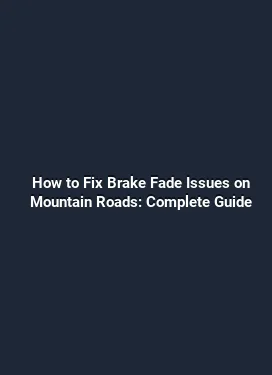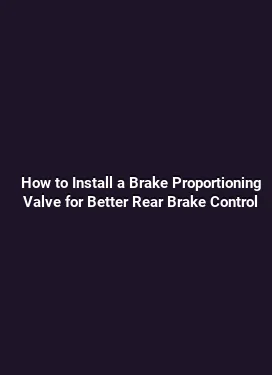Best Lightweight Brake Rotor Options: Aluminum Hat vs Full Steel
Braking performance in vehicles that demand precision and responsiveness often hinges on the choice of components that influence heat management, weight distribution, and overall system stiffness. Among the most debated topics in brake system design is the choice between aluminum hat rotors and full steel rotors. This article dives into the practical implications, material science considerations, and real-world trade-offs behind these two popular configurations. The goal is to provide actionable guidance for enthusiasts, riders, and professionals who want to optimize stopping power without compromising reliability or service intervals.
Weight, Heat, and Structural Dynamics: Why Rotor Design Matters

Brake rotors are not mere discs that convert kinetic energy into heat. They are active components in a dynamic system that includes calipers, pads, wheels, and suspension. The mass of the rotor directly affects unsprung weight, which in turn influences a vehicle’s handling, acceleration feel, and tire contact. Lighter rotors can reduce the moment of inertia and improve initial braking response, but this benefit must be balanced against durability and heat management.
Heat is arguably the most critical factor in rotor performance. Braking generates significant heat, and excessive heat can lead to fade, reduced pad bite, and accelerated wear. The rotor’s ability to dissipate heat depends on material properties, surface design, internal vanes or channels, and overall rotor geometry. Aluminum hat rotors introduce a separation between the wheel hub and the braking surface, which has both mechanical and thermal implications.
Material Properties and Thermal Performance

Full steel rotors are typically made from high-grade cast iron or steel alloys. They offer predictable wear characteristics, excellent thermal conductivity, and robust resistance to deformation under repeated braking. Aluminum hat rotors, by design, use a lighter aluminum hat structure mounted to the wheel hub, with a steel braking surface or a steel-lined ring. The geometry aims to reduce rotational inertia without sacrificing pad contact integrity and disc reliability.
In practice, the aluminum hat reduces the rotational mass during wheel dynamics, which can enhance acceleration and braking responsiveness in some high-performance applications. However, the aluminum-hat section must reliably transfer heat from the braking surface to the hub, relying on contact interfaces and sometimes dedicated heat paths. This introduces considerations around thermal cycling, differential expansion, and long-term joint stability.
Aluminum Hat Rotors: Advantages, Trade-offs, and Use Cases
Aluminum hat rotors are often marketed for their lightweight advantages, which can contribute to improved pedal feel and faster heat dissipation in certain operating regimes. The key is understanding where the weight savings translate into real-world benefits and where the potential downsides appear in daily driving, track days, or off-road scenarios.
Weight Reduction and Handling Benefits
Reducing rotor mass primarily lowers unsprung weight, which can improve suspension response and steering feel. For precise braking systems or vehicles designed for quick direction changes, the lighter rotor helps keep the wheel and tire in better contact with the road during dynamic maneuvers. In practice, the improvement is often more noticeable in high-revving engines or light motorcycles where every gram matters, rather than in heavy street cars where other components dominate inertia.
Beyond pure inertia, lighter rotors can reduce the gyroscopic load during braking transitions, potentially sharpening initial bite and reducing the tendency to fold under braking in aggressive cornering scenarios. This can be particularly valuable in track-focused applications or performance-trepper setups where braking inputs are frequent and varied.
Thermal Management and Surface Interaction
The aluminum hat primarily serves as a heat-friendly interface that supports the brake surface. While aluminum conducts heat, its thermal performance hinges on the effectiveness of the heat path from the braking surface through the hat to the hub. If the path is efficient, heat can spread more evenly, reducing the risk of localized hot spots. If the interface is undersized or poorly bonded, hot spots can still arise, leading to localized pad wear and potential rotor warping over time.
In track environments or repeated high-speed braking, aluminum hats can experience differential thermal expansion relative to the steel braking surface. This can affect runout and pad alignment if not engineered with careful tolerances. For many riders, these considerations are a reminder that aluminum hats require quality construction and consistent manufacturing standards to maintain reliability under load.
Full Steel Rotors: Strength, Durability, and Long-Term Performance
Full steel rotors provide a tradition-backed balance of durability, predictable wear, and enduring performance. They excel in environments where braking is frequent, harsh, or conducted at sustained high temperatures. The steel rotor itself can robustly handle heat cycling, wear, and mechanical stress without the interface challenges that may accompany aluminum hats.
Durability and Longevity
Steel rotors are known for their resilience in the face of repetitive heating and cooling cycles. The kinetic energy absorbed during braking translates into thermal energy that the rotor must dissipate without undergoing excessive deformation or crack formation. In long-term use, steel rotors tend to maintain a stable running surface, which supports consistent pad contact and predictable bite across a broad range of temperatures.
For riders who log high mileage or frequently engage in aggressive braking on downhill segments, the durability of full steel rotors helps maintain performance fidelity over extended service intervals. This reliability is a compelling argument for riders who prioritize longevity and steady performance over lightweight gains.
Consistency in Pad Contact and Wear Patterns
Full steel rotors offer a uniform contact surface that makes pad wear more predictable. When paired with compatible pads and calipers, the braking response remains stable across sessions, rain or shine. This predictability reduces the likelihood of uneven wear patterns that can lead to rotor warping or caliper misalignment, especially in vehicles with less-than-ideal bedding-in conditions.
Another practical aspect is maintenance compatibility. Full steel rotors tend to be more forgiving with a wider range of pad compounds and heat-treating processes. For shop environments or mixed riding habits, the broad compatibility of steel rotors simplifies sourcing and service scheduling.
Practical Guidance: Choosing Between Aluminum Hat and Full Steel Rotors
Ultimately, the decision comes down to the intended use, riding style, and maintenance philosophy. The following considerations help translate theory into actionable choices for street, sport, and track riders alike.
Assessing Riding Conditions and Goals
For riders who prioritize nimble handling and quick response in a light vehicle, and who typically operate at moderate speeds with occasional high-intensity braking, aluminum hat rotors can offer a favorable balance between weight savings and performance. However, this advantage depends on the rotor’s engineering quality, heat path design, and the reliability of the mounting interface. For daily commuting with long service intervals, a full steel rotor’s predictability and durability may be more appealing.
Riders who frequently push their systems to the limit—such as track enthusiasts, performance tuners, and downhill cyclists—often benefit from the robust heat management and consistent wear characteristics of full steel rotors. In these scenarios, spending more time on rotor cooling strategies, pad selection, and rotor bedding procedures pays dividends in lap times and brake pedal confidence.
Considerations for Installation and Maintenance
Installation quality is critical for any rotor type. Aluminum hat designs must ensure a true, concentric mounting surface and a secure interface between the hat and the braking surface. Any play or misalignment can create uneven wear, pulsation, or increased rotor runout, which undermines the intended performance gains. Torque specifications, bolt pattern integrity, and proper centering are essential to realize the lightweight benefits without compromising safety.
Maintenance practices influence long-term results. Regular inspection of the rotor surface for scoring, cracks, or glazing, along with pad condition checks, helps prevent surprises during demanding braking. For aluminum hat configurations, it is particularly important to monitor the hat-to-hub interface for signs of looseness or corrosion, which could degrade structural integrity over time. With full steel rotors, attention to rotor runout, proper bedding-in of new pads, and keeping the braking system clean from contaminants remains a cornerstone of reliability.
Real-World Scenarios: How These Choices Play Out
Consider a lightweight sports car used for weekend spirited driving and occasional track days. In such a setup, swapping to aluminum hat rotors might yield a noticeable improvement in throttle response and initial braking feel, especially when paired with high-friction pads designed for fast heat buildup. However, the driver may experience increased sensitivity to brake fade during prolonged sessions or in environments with high ambient temperatures. A well-engineered aluminum hat rotor discipline, combined with adaptive pad selection, can still deliver strong performance with careful monitoring of brake temps and pad wear.
Now imagine a touring motorcycle or a heavy-duty pickup with frequent city traffic and long downhill descents. In these cases, full steel rotors offer a robust, durable, and consistent braking experience. The predictability of fade resistance and stable bite is valuable when elevation changes and repetitive stopping cycles are common. For riders who log substantial mileage, the benefit of longer rotor life and easier maintenance scheduling can translate into lower total cost of ownership.
Materials, Manufacturing, and Quality Considerations
The production quality of braking components directly influences real-world performance. Aluminum hat rotors rely on precise bonding between the aluminum hat and the braking surface, and some designs may incorporate a steel-lined ring or other hybrid approaches. The durability of this bond, the quality of the machining tolerances, and the environmental resistance of the joint (to moisture, road salt, and heat cycling) are critical to sustaining reliable performance over time.
Full steel rotors benefit from mature manufacturing processes and consistent material properties. The surface finish, rotor thickness tolerance, and proper heat-treatment enable stable friction characteristics and predictable wear. The choice of rotor coatings, such as anti-corrosion finishes or friction-enhancing textures, can further influence maintenance needs and longevity in varied climates.
Gearing Up: Compatible Pad Compounds and Bedding Procedures
Rotor performance is inseparable from pad chemistry and bedding procedures. When integrating aluminum hat rotors, selecting a high-performance pad designed to operate within the rotor’s thermal envelope helps maximize the benefit of reduced unsprung weight. Proper bedding ensures a stable transfer layer, minimizes glazing, and establishes repeatable friction responses across temperature ranges.
For full steel rotors, pad selection often emphasizes durability and heat tolerance. Bedding practices focus on gradually bringing the pad up to operating temperature and avoiding abrupt thermal shocks that could cause glazing or micro-cracking. In all cases, following manufacturer-recommended bedding sequences, torque specs, and maintenance intervals is essential to achieving consistent braking behavior over time.
Summary of Practical Takeaways
- Aluminum hat rotors can provide weight savings and improved initial responsiveness when engineered with high manufacturing precision and robust heat pathways. They are well-suited for lighter vehicles and track-oriented setups where weight management translates to tangible handling benefits.
- Full steel rotors deliver long-term durability, consistent friction behavior, and strong resistance to heat-induced distortion. They excel in high-use environments and for riders prioritizing reliability and straightforward maintenance.
- The choice between these rotor designs should be guided by vehicle weight, braking duty cycle, heat management capabilities, and maintenance philosophy. A thoughtful approach that matches components to driving demand yields the best balance of performance, longevity, and cost.
Exploring the nuanced interplay between rotor mass, heat dissipation, and pad interaction reveals that there is no universally “best” option. Instead, the right choice emerges from aligning engineering outcomes with the anticipated use case, quality of manufacturing, and a disciplined maintenance routine that keeps the braking system operating within its optimal thermal window.






